#Gymnotiformes
Explore tagged Tumblr posts
Text

Electric Eel (Electrophorus electricus), family Gymnotidae, order Gymnotiformes, found in freshwater habitats in northern South America
These predatory fish are able to stun prey using electric shocks of up to 860 volts.
They are not true eels, but are in the same order as neotropical knifefish.
photograph by Oleksandr (Alex) Zakletsky
#electric eel#knifefish#electrophorus#gymnotidae#gymnotiformes#bony fish#ichthyology#fish#central america#south america#animals#nature
503 notes
·
View notes
Text
Taxonomy Tournament: Fish


Gymnotiformes. This order is known as Neotropical knifefish, which have an elongated body and anal fin, and are capable of producing electric fields which they use to detect prey. Members include the electric eel and glass knifefish
Siluriformes. This order is made up of catfish, which have prominent barbels (sensory organs near the mouth) that resemble a cats whiskers.
#animals#biology#polls#poll tournament#zoology#electric eels#fish#catfish#Gymnotiformes#Siluriformes#0x64v0x9b#animal tournament#Animal Tournament Round 1
71 notes
·
View notes
Text
YEEEAAAH GO ORDER GYMNOTIFORMES GO!!! ANAL FIN ALL THE WAY DOWN BABY!!
Was anyone going to fucking tell me that electric eels have their anus directly under their heads because their head is basically their entire main body and they're actually like 90% tail
Or was I just supposed to casually stumble across that information
12K notes
·
View notes
Text

Yesssss new tiny knifefish species described from Brazil, everyone say hello Microsternarchus javieri
Shamelessly copying and pasting from the Fish In The News facebook page:
𝑀𝑖𝑐𝑟𝑜𝑠𝑡𝑒𝑟𝑛𝑎𝑟𝑐ℎ𝑢𝑠 𝑗𝑎𝑣𝑖𝑒𝑟𝑖, a new species of weakly electric knifefish is described from the flooded savanna streams of the Branco River and in terra-firme streams in the mid-and lower portions of the Negro River basin, Amazonas, Brazil.
Open-access - https://www.scielo.br/j/aa/a/4hGwQYNxjyGgpQP5XJF73Ft/
𝗥𝗲𝘀𝗲𝗮𝗿𝗰𝗵 𝗧𝗶𝘁𝗹𝗲
𝑀𝑖𝑐𝑟𝑜𝑠𝑡𝑒𝑟𝑛𝑎𝑟𝑐ℎ𝑢𝑠 𝑗𝑎𝑣𝑖𝑒𝑟𝑖, a new species of weakly electric fish (Gymnotiformes: Hypopomidae, Microsternarchini) from the Negro River basin, Amazonas, Brazil
𝗖𝗶𝘁𝗮𝘁𝗶𝗼𝗻
ESCAMILLA PINILLA, C., COX FERNANDES, C., & ALVES-GOMES, J. A.. (2025). 𝑀𝑖𝑐𝑟𝑜𝑠𝑡𝑒𝑟𝑛𝑎𝑟𝑐ℎ𝑢𝑠 𝑗𝑎𝑣𝑖𝑒𝑟𝑖, a new species of weakly electric fish (Gymnotiformes: Hypopomidae, Microsternarchini) from the Negro River basin, Amazonas, Brazil. Acta Amazonica, 55, e55bc24175. https://doi.org/10.1590/1809-4392202401751
𝗔𝗯𝘀𝘁𝗿𝗮𝗰𝘁
Here we describe a new hypopomid species, 𝑀𝑖𝑐𝑟𝑜𝑠𝑡𝑒𝑟𝑛𝑎𝑟𝑐ℎ𝑢𝑠 𝑗𝑎𝑣𝑖𝑒𝑟𝑖i n. sp., encountered in flooded savanna streams of the Branco River and in terra-firme streams in the mid-and lower portions of the Negro River basin. We compared this new species with 𝑀. 𝑏𝑖𝑙𝑖𝑛𝑒𝑎𝑡𝑢𝑠 from the San Bartolo River, Venezuela, and M. brevis from the upper portion of the Negro River.
We also compared this new species with two recently described species in the genus 𝑀𝑖𝑐𝑟𝑜𝑠𝑡𝑒𝑟𝑛𝑎𝑟𝑐ℎ𝑢𝑠, 𝑀. 𝑙𝑜𝑛𝑔𝑖𝑐𝑎𝑢𝑑𝑎𝑡𝑢𝑠 and 𝑀. 𝑠𝑐ℎ𝑜𝑛𝑚𝑎𝑛𝑛𝑖. We examined morphometrics, anatomical characters, DNA barcode distances for the COI (cytochrome C oxidase subunit I) gene, and electric organ discharge (EOD) parameters. We diagnosed 𝑀. 𝑗𝑎𝑣𝑖𝑒𝑟𝑖 n.sp. based on variation in maximum body depth, eye diameter, caudal vertebral counts, number of anal fin rays, and the shape of the maxillae. The average intra-specific genetic distance (K2P) in 𝑀. 𝑗𝑎𝑣𝑖𝑒𝑟𝑖 n.sp. was 0.83%, whereas the average inter-specific genetic distance to 𝑀. 𝑏𝑟𝑒𝑣𝑖𝑠 was 12.45%, and to other hypopomids ranged from 17.21 to 21.54%. When comparing EOD waveforms of the new species with 𝑀. 𝑏𝑟𝑒𝑣𝑖𝑠, we found differences in repetition rate, the ratio between the first and second phase areas, and the polarity balance.
The description of 𝑀. 𝑗𝑎𝑣𝑖𝑒𝑟𝑖 n. sp. increases to five the number of species in the genus.
𝗘𝘁𝘆𝗺𝗼𝗹𝗼𝗴𝘆
The specific epithet, 𝑗𝑎𝑣𝑖𝑒𝑟𝑖, is in honor of the late Javier Maldonado Ocampo, whose research on gymnotiforms, systematics, and conservation greatly contributed to our understanding of the Neotropical ichthyofauna. A masculine noun in apposition.
𝗣𝗵𝗼𝘁𝗼 𝗖𝗿𝗲𝗱𝗶𝘁
Lateral view of 𝑀𝑖𝑐𝑟𝑜𝑠𝑡𝑒𝑟𝑛𝑎𝑟𝑐ℎ𝑢𝑠 𝑗𝑎𝑣𝑖𝑒𝑟𝑖 n. sp. from the Negro River basin. A - Holotype (INPA-ICT 060886), 98.6 mm TL, 67.6 mm LEA; B - Paratype (ANSP 212283), 101.2 mm TL, 62.0 mm LEA; C -Non-type (INPA-ICT 28591), 86.9 mm TL, 60.4 mm LEA live specimen.
Copyright © 2025 the Author(s). Published in Acta Amazonica journal. This paper is released under a Creative Commons Attribution 4.0 International (CC BY 4.0) licence. https://creativecommons.org/licenses/by/4.0/
#NewSpeciesAlert #NewSpecies #Ichthyology #Ictiology #Taxonomy #Biodiversity #Aquarium #AquariumHobby #Fishkeeping #Fishkeeper #Aquarist #Knifefish #ElectricFishes #ElectricFish #WeaklyElectricFish #Microsternarchus #Gymnotiformes #Hypopomidae #Microsternarchini #Amazonas #Neotropical #NeotropicalFishes #NegroRiver #RioNegro #Gymnotiforms #Systematics
35 notes
·
View notes
Text
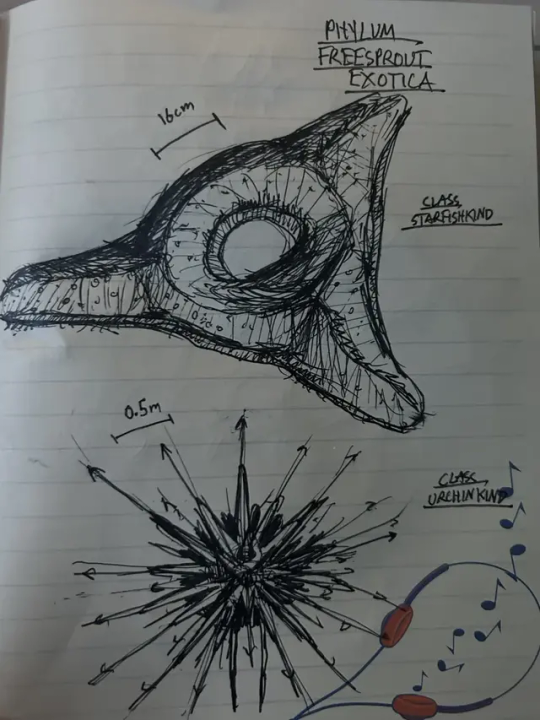
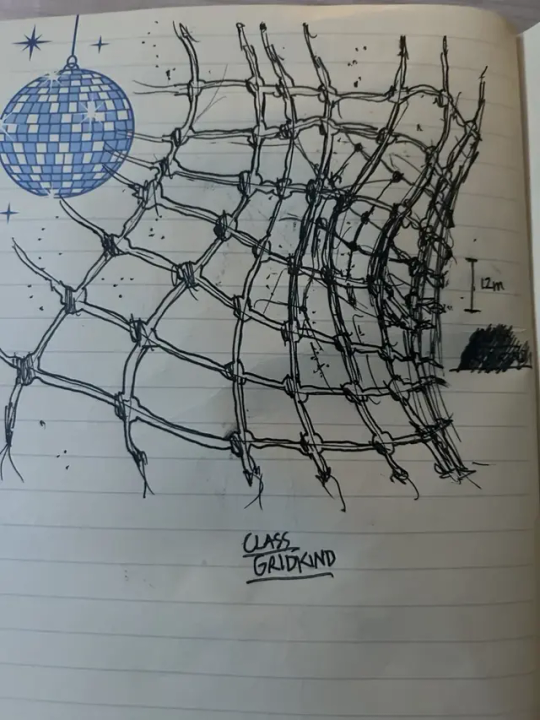

Still in Superphylum Outersymmetrum
(AN1 B2) Clade: Erithrospermia
A clade of outersymmetrums that contain pointed radially symmetric forms for the entire duration of the life-cycle and contain a semi-flexible keratin shell.
PHYLUM FREESPROUT EXOTICA
Phylum containing radial point-symmetry with extrusions ending in a dermal layer, a flat underside, a single cloaca for intake and excretion, and reproduce via fragmentation or sexual diaspores.
(AN1 B2-a) Clade: Orchinadae
A clade of animals orienting their internal anatomy around a vacant cavity at the center of symmetry, used for orientation and pressure regulation, and containing a segmented brain chord.
Class Starfishkind
Class of orchinadae that have muscular tubes on ends of a variating number of rays, can detach and reattach an anterior end to and from the posterior end, and locomote via floundering, tube-based ciliary locomotion, and gymnotiform swimming; vacant cavity exposed to open water on two sides.
Class Urchinkind
Class of orchinadae that have barbed and toxic quills on the end of ray lobes, rays and ends are on non-flexible fixed positions, locomote via rolling and ciliary locomotion during adolescence and reproduction and are stationary during adulthood, vacant cavity exposed to open water on one side.
(AN1 B2-b) Clade: Gridkind
A clade of animals all containing multiple nodes of nerve nets with geometric symmetry, interlinked with collagen and elastin, and using an ammonia salt-based circulation and waste system.
Class Gridkind
Class of clade gridkind that uses full ectothermy, resides in only saltwater, and has cnidocytes lining the outer dermal layer.
(AN1 B2-c) Clade: Prototekradia
A clade of animals with a central organ lobe in a flat disk, using protruding spikes for defense, hunting, and consuming.
Class Spikediscs
Class of prototekradia that are mobile during most of their entire life, use rotational locomotion to move across the seafloor, a buoyant bladder to keep upright, and an exaggerated extension on the sagittal plane.
Class Seamines
Class of prototekradia that are mostly immoble during their life, attach themselves to the seafloor with an armored stalk, use multiple sets of buoyant bladders to raise near the surface of the sea, and a bloated spike-lined posterior end.
Yes, I'm sure you've all noticed the EXTREMELY creative names such as.... STARFISHKIND.... and URCHINKIND..... Again, these are just for namesake and I named these when I was deep in the college semester so my brain was already mush by then.... Both of those classes have a hollow center that they either use for buoyancy, orientation, wrapping around organisms, or rooting. The starfishkind actually typically look more like floundering or odd-shaped walking organisms in the sea, and only form the shape illustrated when latched to an algae/bacterial/fungal filled rock (which is a significant portion of their day lol). Urchinkind depend on the species, but the barbs on the top and sides actually act more like quills than actual urchin spikes, and organisms will typically unfurl or flatten into a bread-dough like shape when docile.
#art#digital art#artists on tumblr#worldbuilding#jomgol#spec bio#spec evo#speculative biology#speculative evolution#xenobiology#speculative zoology#alien species#alien#creature design#creature#speculative worldbuilding
20 notes
·
View notes
Text
Pesquisadores fazem expedição em busca de peixes-elétricos na Amazônia
Um grupo de pesquisadores inicia nesta terça-feira (20) expedição para buscar no fundo do Rio Negro, no Amazonas, em igarapés e outros ambientes na região, espécies pertencentes à ordem dos Gymnotiformes, conhecidos como peixes-elétricos. Além de identificar novas espécies, os pesquisadores pretendem contribuir para a conscientização e preservação da biodiversidade local. A expedição é parte do…

View On WordPress
0 notes
Text
Mountain goat:
"Despite its vernacular name and both genera being in the same subfamily (Caprinae), the mountain goat is not a member of Capra, the genus that includes all true goats (such as the wild goat (Capra aegagrus), from which the domestic goat is derived); rather, it is more closely allied with the other bovids known as “goat-antelopes”..." [Source: Wikipedia]
Electric eel:
"...this fish is not considered a “true” eel. While true eels are classified in the order Anguilliformes, the electric eel is actually in the order Gymnotiformes, the knife fishes." [Source: aqua.org]
King cobra:
"it is not phylogenetically a true cobra despite its common name and some resemblance" [Source: Wikipedia]
It's also not one species...
"In the 2021 study, a DNA analysis that accounted for almost the entire distribution range of king cobras identified four distinct genetic lineages. These lineages were classified as confirmed candidate species — species yet to be formally described and named." [Source: livescience.com]
Maned wolf:
"Its markings resemble those of foxes, but it is neither a fox nor a wolf. It is the only species in the genus Chrysocyon (meaning 'golden dog' in Ancient Greek" [Source: Wikipedia]
Peacock mantis shrimp:
"...these charming crustaceans aren't actually true shrimp — instead more of a distant cousin. Despite their common name, these colorful critters belong to the Stomatopoda squad, an order exclusively of mantis shrimp that either punch or spear their prey." [Source: Monterey Bay Aquarium]
Horny toad:
Also called horned lizards or horntoads, these are lizards from the genus Phrynosoma.
"Phrynosoma means 'toad-bodied'... The spines on the lizard's back and sides are modified reptile scales, which prevent water loss through the skin, whereas the horns on the head are true horns (i.e., they have a bony core)." [Source: Wikipedia]
I have just learned that Mountain Goats are NOT, in fact, actual Goats.
206K notes
·
View notes
Text
something i think a lot of people miss because its name is EELektross but the tynamo line is in very large part based on lampreys.
lampreys are incredibly basal (resembling the ancestral form, "primitive") vertebrates- agnathans (non-jawed) are a group of fishes that include the lampreys and the hagfish, which split off from the rest of the fish we know before moving jaws existed. they can give us a good idea of what some of the earliest vertebrates kind of looked like! they have one big sucker mouth, just like eelektrik and eelektross! (all photos via wikipedia unless otherwise mentioned)

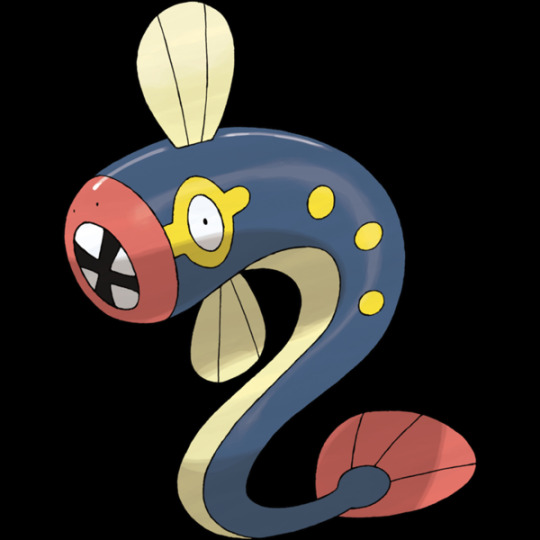
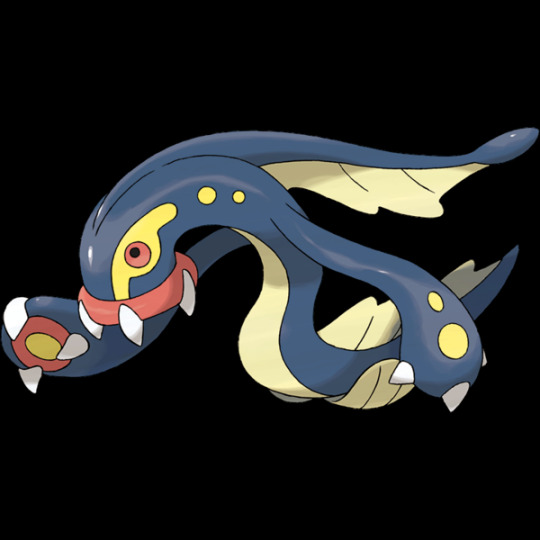
also very of note are the dots down the side of the head on both of these- they're lamprey gill slits! unlike the operculum of most bony fishes or the multiple tall gill slits of the cartilaginous fishes, lamprey gill slits are largely circular.
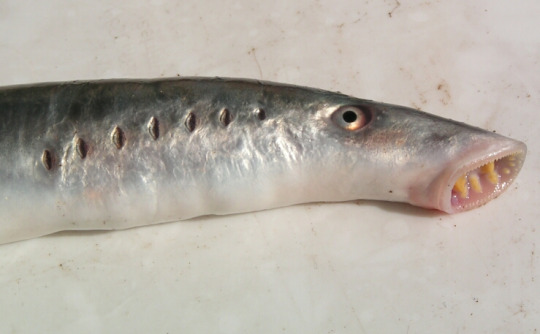
now, tynamo i'm a bit split on whether it more closely resembles eel larvae (leptocephalus) or lamprey larvae (ammocoetes).
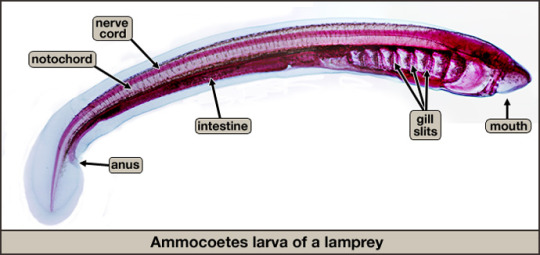
(photo via brian mccauley)

in case you didn't know, fish have larval stages! they're tiny and often weird and transparent looking. both ammoecoetes and leptocephali feed on tiny particles floating through the water (suspension feeding). i think with their white color and transparentish look, tynamo more resemble the leptocephali, but obviously with an ammocoete's jawless always-open mouth.
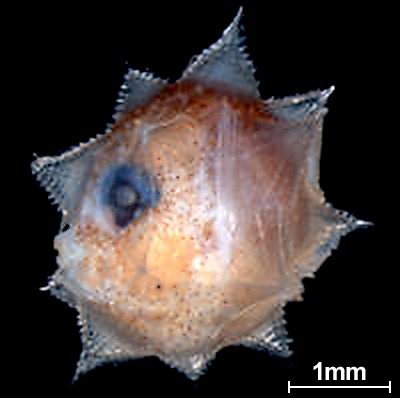
not relevant for our lamprey/eel discussion, but this is the larval form of the giant ocean sunfish, aka the mola mola. fucking look at it
also, a note! in addition to lampreys, the line obviously is a play on electric eels.
electric eels............are not eels.
eels are everything within the group anguilliformes. they're a big diverse group of mostly long and snake-looking fishes. this is an african conger, it's one of the prettiest eels in my opinion.

electric eels, despite the name, are indeed not eels. they're part of the gymnotiformes instead, the south american knife fish. all members of this group use electricty as a sense- they use weak electric fields kind of like an analogue to a bat's echolocation, to navigate and find food. only one genus within this group, Electrophorus, can actually shock stuff. the three species within that genus are the electric eels!
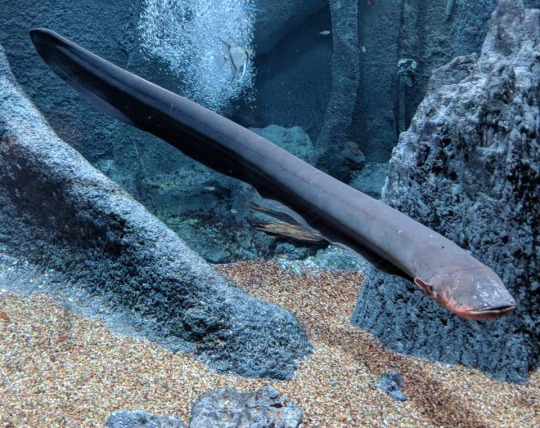
(photo via use ungulatenerd92 on zoochat)
they're funny looking guys. anyways, uh, pokemon or whatever
337 notes
·
View notes
Text
Tynamo Analysis
Uniquely for a fish pokemon, Tynamo’s entire line lacks any form of water typing, instead being purely electric. The more traditional fish body type, coupled with its white body, large eyes, and translucent fins, point to two influences: the leptocephalus, or larval stage of the true eels, and the body shape of the knifefishes (order Gymnotiformes), electric fishes most famous for the electric eel. There are also similarities to ammocoetes, the larval lamprey. Tynamo, unlike its evolutions, is primarily eel-like, not even possessing the famous teeth.
Tynamo has far weaker electrical powers than its relatives, but it makes up for weakness in lack of control. Tynamos swim in close schools, and the discharge from the agitated young can stun most larger predators, as well as killing their prey. Their whole line generates electricity from the lateral line and 3 organs just behind the mouth, though in Tynamo they reach into the abdomen and create a yellow pattern through their skin- these are the main organ, Hunter’s organ, and Sach’s organ. These organs allow them to regulate the strength of their discharges.
Unlike their evolutions, who are capable of waddling, Tynamo are fully aquatic. They use buccal pumping and are capable of breathing, but it is unwise to keep a Tynamo out of water for long periods. If it must be done, they have to be kept wet. In Unovan caves, due to the limestone and other rocks, water is near constant and the walls are soaked; perhaps this, along with the magnetic fields they produce, is what attracts Eelektrik/Eelektross parents to such a nursery. The magnetic stones are used as suckerholds, with the young Tynamos hanging onto them, perhaps for a hold in the current or to siphon electricity. Tynamo are recorded as feeding on aquatic invertebrates such as cave Corphish*, as well as the occasional Joltik. As they approach evolution age, however, they are known to become bolder in their targets.
*Cave Corphish are morphs of the Corphish line, being far smaller and nearly white. They are blind and possess larger feelers to navigate the rivers of caverns.
5 notes
·
View notes
Text
Animal Crossing Fish - Explained #167
Brought to you by a marine biologist who is trying not to do all the cool ones first...
CLICK HERE FOR THE AC FISH EXPLAINED MASTERPOST!
Let’s be real - not all of the fish presented in the AC franchise can be super cool. They can’t all be as awesome as the sharks or as cute as the frog or as weird and wonderful as the Barreleye. I’ve been humbled a few times by you guys, though - there have been fish that explode in popularity and I have no idea why, and then ones I think are really awesome have been mostly ignored. But I think we can all agree that today’s fish - the black ghost knifefish - is cool af, not just because of it’s looks, but because it’s electric!

The black ghost is another Pocket Camp fish that was around for a few days in October of last year (probs because it’s so perfect for Halloween) and then that was it. Pocket Camp is really kind of crappy that way, but I can’t get over the types of fish they include. If you’ve seen this thing in a pet store, you know as well as I do that they are even more wild and awesome irl.
The Black Ghost Knifefish is named to species - Apteronotus albifrons. It comes from the Order Gymnotiformes, the South American knifefish. There are about 250 species, the most famous of which is the Electric Eel (another friend who is not an eel despite its name!) These fish are almost exclusively fresh water species, except a few notable exceptions that travel into brackish water to feed. All of the Gymnotiformes move by undulating their very long anal fin that extends for much of the length of their bodies. They are also nocturnal which, makes them very interesting, but not very visible, pets.

All Gymnotiformes fish are weakly electric (except for the electric eel, which can use its electricity to attack and defend). So, a black ghost cannot electrocute you, but it’s fascinating what they can do. Most knifefish use their electricity to sense their environments, called electrolocation. It’s just like echolocation in dolphins, except these are electrical signals, not auditory. The black ghost sends out pulsing electric signals and then can determine its environment by the electrical change it senses in its electrosensors, which are like little pores along its body. The amplitude and timing of the returning signals tells the black ghost about how its environment is shaped. So, even in the dark, the black ghost can “see” fairly well. The electric charge is generated in an electric organ found in the tail which houses a small group of cells that can discharge electricity at frequencies close to 2000 times a second - the fastest in the animal kingdom!
Black ghosts also use this electricity to communicate with one another and can tell each other apart by sex, age, and even subordination via the frequency of their electric pulses. Needless to say, much of the black ghost’s brain is dedicated to reading its own and other ghost’s electric signals!
And there you have it! Fascinating stuff, no?
#black ghost knifefish#fish#animal crossing#animal crossing pocket camp#freshwater#animals#knifefish#science in video games#animal crossing fish explained
11 notes
·
View notes
Text
SO: Taxonomy/Phylogeny fun times!
So, all vertebrates belong to the phylum Chordata, they're Chordates, everything is a fish so the there's no such thing as a "fish" scientifically speaking. Cool? Cool. If it's a fish and has bones, it's your distant cousin.
First off, Electric Eels aren't Eels. Europeans called them eels because they looked like eels (Puraké was the name in Tupi, lit. "one that numbs"), but actually, they're a knifefish; specifically, they belong to the family Gymnotidae, the Naked-Back Knifefishes: knifefish that all have electrosensory organs and are found in south America. If you can sense electricity, you can hold electricity. If you can hold electricy, you can spend generations holding more electricity than is safe for others not meant to hold electricity, allowing you to do a dangerous discharge to kill bigger prey or defend against just about anything that isn't far away and well grounded/insulated.
Their family belongs to the order Gymnotiformes, or Neotropical/South American Knifefish. first cousins many times removed from the order that contains piranhas, as well as an order known as Siluriformes!
Siluriformes is an order that contains literally all catfish, which are known for their barbs and their electrosensory organs that they use to find food in murky water!
To recap: Puraké (Electric Eels) and Egyptian electric catfish both have common ancestors a fairly short ways back in the geologic-timescale-sense, both had ancestors with electrosensory organs, and both used those to develop extra special organs that deliver a shock defense. Similar roots led to the same conclusion in more than one spot! convergent evolution!
Note: This is a chemist's amateur phylogeny for average tumblr users. Biologists, feel free to correct me, would love to know more
Have you seen this post?

You probably have. It currently has over 120,000 notes, largely because of this addition.

Of course it's going to get reblogged, this kind of unsourced factoid does numbers on here. But something about it wasn't quite right.
A bit of searching turned up the origin of the "fact".


Alright, so it's someone who posted this on reddit 4 years ago and somehow ended up in the search hits. And the post confuses the electric eel (from South America) with the electric catfish (from the Nile, which the Egyptians would have known about).
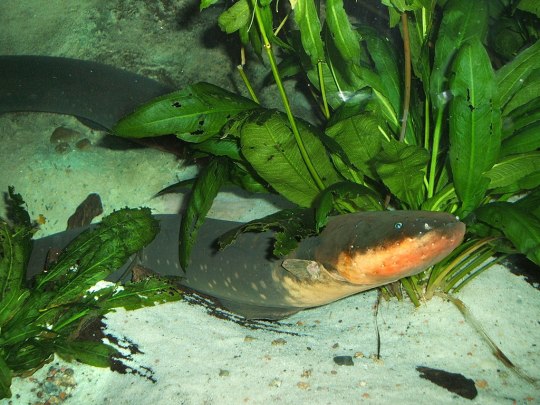
Reminder: this is an electric eel (Electrophorus electricus). It is from South America. (image from Wikipedia)
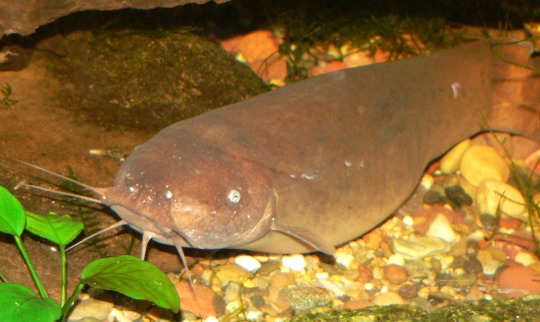
And this is an electric catfish (Malapterurus electricus). It is from the Nile and would have been familiar to the ancient Egyptians. (image from Wikipedia)
And then of course people were speculating in the notes to that post about trade routes between South America and Egypt. Excellent scholarship everyone.
At this point I was ready to call it another made-up internet fact that gets reified by people repeating it. But something was still bothering me.
An ancient Egyptian slab from 3100 BC. What could that be...
Oh.

The Narmer palette. It's the goddamn Narmer palette. (image, once again, from Wikipedia)
So where is this "angry catfish"?
It's not the Egyptian name for the electric catfish.
It's... Narmer. It's Narmer himself.

Narmer's name is written as above (detail of top middle of the palette), using the catfish (n`r) and the chisel (mr), giving N'r-mr. The chisel is associated with pain, so this reads as "painful catfish", "striking catfish", or, yes, "angry catfish" or other similar variants, although some authors have suggested that it means "Beloved of [the catfish god] Nar".
So.
Where does this leave us?
It would appear that this redditor not only confused electric eels with electric catfish, but also confused a Pharaoh's name with the name of a fish. And then it got pushed to the top search hits by a crappy search engine and shared uncritically on tumblr.
In short, "the electric eel is called angry catfish" factoid actually literacy error. Angry Catfish, who ruled upper Egypt and smote his enemies, is an outlier adn should not have been counted.
Also the Arabic name for the electric catfish is raad (thunder) or raada (thunderer).
References
Afsaruddin, A., & Zahniser, A. H. M. (1997). Humanism, culture, and language in the Near East: studies in honor of Georg Krotkoff. Eisenbrauns.
Clayton, P. A. (2001). Chronicle of the Pharaohs. Thames & Hudson.
Godron, G. (1949). A propos du nom royal. Annales du Service des antiquités de l'Egypte, 49, 217-221.
Sperveslage, G., & Heagy, T. C. (2023). A tail's tale: Narmer, the catfish, and bovine symbolism. The Journal of Egyptian Archaeology, 109(1), 3-319.
45K notes
·
View notes
Text


Electric Eel (Electrophorus electricus), family Gymnotidae, order Gymnotiformes, found in freshwater habitats in northern South America
These predatory fish are able to stun prey using electric shocks of up to 860 volts.
They are not true eels, but are in the same order as neotropical knifefish.
photograph via: Long Island Aquarium
#electric eel#electrophorus#gymnotidae#gymnotiformes#fish#ichthyology#animals#nature#south america#central america
395 notes
·
View notes
Text
Electric eels aren’t actually eels.
Nope they are actually part of the order Gymnotiformes (eels are part of order Anguiliformes) and are more closely related to catfish and carp.
Electric eels live exclusively in fresh water ecosystems in South America, whereas most eels live in marine ecosystem. Electric eels can also breath air for some reason, because I guess being about to generate 600 volts of electricity wasn’t intimidating enough.
Oh yeah they can create electricity. That’s a thing.
They can grow to be 9 ft/ 3 m long (what) and weigh up to 50 lbs/ 23 kg.
In summary electric eels are basically stretched out, tube-shaped catfish that can shock their prey like Pikachu.
#newts thoughts#nature#wildlife#ecology#electric eel#this is why naming species by appearance only is confusing#by that logic olives can be classified as dolphins#or coconuts as mammals#petition to rename electric eels ‘shocky noodle fish’
9 notes
·
View notes
Text
straight friend groups: chad, jessica, veronica, michael, ron
gay friend groups: anguilliform swimmer, subcarangiform swimmer, carangiform swimmer (they're subcarangiform's partner), thunniform swimmer, ostraciiform swimmer, amiiform swimmer, gymnotiform swimmer, balistiform swimmer, tetraodontiform swimmer, rajiform swimmer (non binary), diodontiform swimmer and labriform swimmer (only one who knows how to drive)
2 notes
·
View notes
Text
eDNA sequencing will enable scientists to explore piscine diversity in the Amazon without catching fish

- By André Julião , Agência FAPESP -
A scientific expedition in the Javari River basin on the border between Brazil, Colombia and Peru has shown use of environmental DNA sequencing to be feasible to investigate fish diversity in the Amazon. The eDNA method consists of extracting molecules of DNA present in water samples and identifying the species to which they belong by means of genetic markers.
An article on the research published in the journal Scientific Reports also discusses the limitations of the technique for the study of environments as highly diverse as Amazonia.
“We need to continue catching and identifying animals by traditional methods in order to create libraries of genetic material. They will serve as a reference for comparing whatever is found in water samples. As the technique advances, in a few years we may be able to know about all the fish species present in a place without catching them,” said Carlos David de Santana, a research associate at the Smithsonian Institution’s National Museum of Natural History in the United States and first author of the article.
The study was part of the project “Diversity and evolution of Gymnotiformes”, supported by FAPESP and led by Naércio Menezes, a professor at the University of São Paulo’s Zoology Museum (MZ-USP) in Brazil. “The extraction of DNA from water samples creates expectations that are highly favorable to protection of the environment, as the usual methods for collecting samples of aquatic animals include the use of nets and other fishing gear with a negative impact,” said Menezes, a co-author of the article.
The group of researchers spent 18 days on the Javari River, collecting water samples at three of 46 locations where they collected fish specimens. The number of species represented reached the surprising total of 443, and 60 were new to science.
At the sites from which water for eDNA analysis was collected, 201 species were caught using traditional methods. However, only 58, or 26% of the total, were identified with precision at the species level from analysis of the eDNA.
“A possible explanation is lack of reference genetic material in databases that can be used for purposes of comparison. In addition, many species in these locations are entirely new and have never been identified before using conventional techniques,” said Gislene Torrente-Vilara, a professor at the Federal University of São Paulo’s Institute of Marine Sciences (IMAR-UNIFESP) in Santos and also a co-author of the article.
Torrente-Vilara led the expedition as part of the Amazon Fish project, an international collaboration that was supported by FAPESP and resulted in a new understanding of the distribution of fish species in the region (more at: agencia.fapesp.br/31956).
DNA in 100 milliliters of water
To sequence the eDNA, the researchers first collected 100 milliliter surface water samples at three predetermined locations. The samples were filtered and mixed with a solution to prevent degradation of the eDNA.
The 12S mitochondrial RNA gene is the marker most widely used worldwide to identify fish species from eDNA. To find this small piece of genetic code in the water samples, the researchers used DNA extraction kits designed for analysis of both blood and tissue. Excrement and animal parts present in the water can be “captured” by the technique.
However, 12S is a slowly evolving piece of genetic code and might not be sufficient to identify all fish specimens at the species level because many species in the Amazon diverged more than once millions of years ago (recently in evolutionary terms).
For the same reason, eDNA sequencing provided a precise portrait only of the orders represented in the samples. It also differentiated the communities that live in large rivers from those that inhabit small streams deep in the forest (igarapés).
The Amazon basin is home to the highest freshwater fish diversity in the world, with more than 2,700 scientifically described species belonging to 18 orders, 60 families, and over 500 genera.
“Even with an adequate library, it would be very difficult to identify everything at the species level with just this marker,” Santana said. “Two electric eels that diverged recently, for example, Electrophorus voltai and E. electricus, could appear to be a single species” (more about electric eels at: agencia.fapesp.br/31386).
The researchers expect the technique to improve enough in the years ahead for more than one DNA sample to be sequenced simultaneously, so that species can be defined precisely. Until then it will be necessary to create genetic reference libraries, and Santana plans to catalog genetic material from at least all fish families and most fish genera in the Amazon.
In this context, the authors stress that natural history museums are ideal institutions for creating genetic reference libraries and storing environmental samples. As technologies advance, the material deposited can be sequenced with growing precision.
“Museums conserve samples of biodiversity for a very long time and make them available for study by future generations. To keep genetic material viable for such long periods, however, they need to implement cryogenic facilities, or significantly expand the ones they have, rearranging their physical layout and acquiring massive amounts of equipment, such as ultra low temperature freezers and liquid nitrogen tanks,” said Aléssio Datovo, another co-author of the article and fish curator at MZ-USP, the first institution in Brazil to collect samples of eDNA.
The technique can also be used for environmental monitoring, and even to engage schools and riverine communities in conservation initiatives via citizen science programs (more at: agencia.fapesp.br/37085).
The article “The critical role of natural history museums in advancing eDNA for biodiversity studies: a case study with Amazonian fishes” is at: www.nature.com/articles/s41598-021-97128-3.
This text was originally published by FAPESP Agency according to Creative Commons license CC-BY-NC-ND. Read the original here.
--
Read Also
Predicting the biodiversity of rivers
0 notes
Text
Huh. Had to look it up. The king cobra is its own genus, Ophiophagus, and genetic analysis says it's more closely related to the mambas of Africa than it is to any of the true cobras in the Naja genus. Similarly, electric eels are in the genus Electrophorus, in the knifefish order Gymnotiformes, which makes them closer related to catfish than the true eels over in the genus Anguilliformes.

— Paige Lewis, “The Terre Haute Planetarium Rejected My Proposal” from Space Struck
9K notes
·
View notes